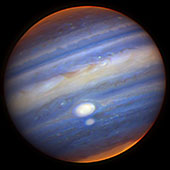Jupiter in Infrared
This image was obtained in near-infrared light using adaptive optics which corrects, in real-time, for most of the distortions caused by turbulence in Earth's atmosphere. The result is a view from the ground that rivals images from space. In the near-infrared, the red spots appear white rather than the reddish hue seen at visible wavelengths. Both red spots are massive storm systems. The top of the larger one, known for a long time as the Great Red Spot, lies about 8 kilometers (5 miles) above the neighboring cloud tops and is the largest hurricane known in the solar system. The smaller storm (officially called Oval BA, but informally known as Red Spot Junior) is another hurricane-like system. Since it appears nearly as bright as the Great Red Spot in near-infrared images, Red Spot Junior may be at a similar height in the Jovian atmosphere as the Great Red Spot. Red Spot Junior is roughly half the size of its famous cousin, but its winds blow just as strong. This mighty new storm formed between 1998 and 2000 from the merger of three long-enduring white ovals, each a similar storm system at a smaller scale, which had been observed for at least 60 years.
| Observatory: | Gemini Observatory (North) Mauna Kea, Hawai'i |
|---|---|
| Telescope: | Gemini North |
| Instrument: | NIRI |
| Astronomer: | C. Trujillo and S. Fisher (Gemini Observatory) and T. A. Rector (University of Alaska Anchorage) |
| Date of Observation: | 07-14-2006 |
| Filters and Assigned Colors: | Paschen Beta (blue), Methane (green) and K-2.2 microns (red) |
| Exposure Times: | 9x0.7 sec, 9x1.3 sec and 9x2.0 sec |
| Location of Image: | Solar System |
| Field of View: | 41x41 arcsec |
| Orientation: | North is up, East is to the left |
| Link to Larger Image | |
| Link to Full Resolution Image | |
| © Copyright Statement |
